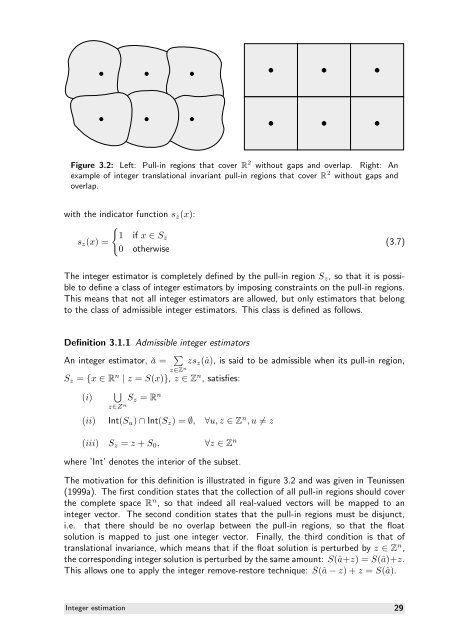The GNSS integer ambiguities: estimation and validation
The GNSS integer ambiguities: estimation and validation
The GNSS integer ambiguities: estimation and validation
Create successful ePaper yourself
Turn your PDF publications into a flip-book with our unique Google optimized e-Paper software.
Figure 3.2: Left: Pull-in regions that cover R 2 without gaps <strong>and</strong> overlap. Right: An<br />
example of <strong>integer</strong> translational invariant pull-in regions that cover R 2 without gaps <strong>and</strong><br />
overlap.<br />
with the indicator function sz(x):<br />
<br />
1 if x ∈ Sz<br />
sz(x) =<br />
0 otherwise<br />
(3.7)<br />
<strong>The</strong> <strong>integer</strong> estimator is completely defined by the pull-in region Sz, so that it is possible<br />
to define a class of <strong>integer</strong> estimators by imposing constraints on the pull-in regions.<br />
This means that not all <strong>integer</strong> estimators are allowed, but only estimators that belong<br />
to the class of admissible <strong>integer</strong> estimators. This class is defined as follows.<br />
Definition 3.1.1 Admissible <strong>integer</strong> estimators<br />
An <strong>integer</strong> estimator, ǎ = <br />
zsz(â), is said to be admissible when its pull-in region,<br />
z∈Z n<br />
Sz = {x ∈ Rn | z = S(x)}, z ∈ Zn , satisfies:<br />
(i)<br />
<br />
Sz = Rn z∈Z n<br />
(ii) Int(Su) ∩ Int(Sz) = ∅, ∀u, z ∈ Z n , u = z<br />
(iii) Sz = z + S0, ∀z ∈ Z n<br />
where ’Int’ denotes the interior of the subset.<br />
<strong>The</strong> motivation for this definition is illustrated in figure 3.2 <strong>and</strong> was given in Teunissen<br />
(1999a). <strong>The</strong> first condition states that the collection of all pull-in regions should cover<br />
the complete space R n , so that indeed all real-valued vectors will be mapped to an<br />
<strong>integer</strong> vector. <strong>The</strong> second condition states that the pull-in regions must be disjunct,<br />
i.e. that there should be no overlap between the pull-in regions, so that the float<br />
solution is mapped to just one <strong>integer</strong> vector. Finally, the third condition is that of<br />
translational invariance, which means that if the float solution is perturbed by z ∈ Z n ,<br />
the corresponding <strong>integer</strong> solution is perturbed by the same amount: S(â+z) = S(â)+z.<br />
This allows one to apply the <strong>integer</strong> remove-restore technique: S(â − z) + z = S(â).<br />
Integer <strong>estimation</strong> 29
















